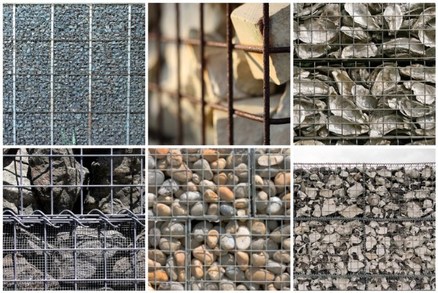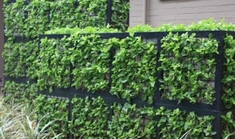|
Recently my friend Lisa invited me to her Boise foothills home for happy hour. I’d not visited in a while, and arrived to find her in the midst of a major backyard renovation. As with many foothills lots, her existing back yard is steeply sloped. Because of this, master plan improvements were focused on earth retention to carve out flat areas for a couple of patios—one off the main living space, and one higher up the slope to take advantage of a downtown view. In the new design, retaining walls and seat walls were constructed of gabion baskets. Though I’ve known about gabions for years, I’d never seen them used like this -- as a featured element in a residential landscape.  Not Lisa's yard - but a great residential installation. Location unknown. Not Lisa's yard - but a great residential installation. Location unknown. For those who don’t know, gabions (say: GAY’-bee-uns) are a traditional retaining wall system comprised of steel mesh ‘baskets’ filled with rocks. Both the broad footprint and weight of the rocks oppose the overturn force of the earth being retained. Put simply, they’re big and heavy and really effective at holding back slopes. In Lisa’s yard, the designer had employed a gabion wall system to create terraced patios and seating, choosing to leave exposed the steel baskets and the rock within. The visible raw materials created an aesthetic that felt both primitive and modern at the same time. When I admired it, Lisa laughed ruefully and said a number of friends had asked if the walls would eventually be covered with stucco or some other finish. Most had been surprised to hear, “No. They’re just steel cages filled with rocks.” All the same, Lisa clearly loved the effect as much as I did. Gabions are nothing new. They have their roots in engineering, and were in use as early as the Italian Renaissance, where there is mention of Leonardo Da Vinci designing a type of gabion to construct a foundation for the San Marco Castle in Milan.  Civil War era use of wicker gabions, Virginia Civil War era use of wicker gabions, Virginia Historically, gabions were sometimes used for military fortifications – as in parapet walls to protect shooting positions – and valued for their lightweight baskets (once woven of wicker), which proved easy to transport and could be filled with materials native to the local area. In the civilian United States, gabions were first commonly used in the early 20th century for engineering purposes such as bridge, dam, roadway, and foundation construction. Other modern applications – in realms hydrologic and ecologic – include stream bank stabilization and the construction of fish ladders. Indeed, they are a tried-and-true engineering tool, but to see such a utilitarian construction method featured front-and-center – in a residential landscape, no less – surprised me. Curious to learn more, I checked in with Chuck Edwards, our chief residential designer at Breckon landdesign, to ask if he had any experience with them. Not surprisingly, he was familiar with gabions and their applications to modern design. In fact, Chuck had recently completed a master plan for a foothills residence (3D Visualization above) that featured gabions as an art element. The sides of the baskets in Chuck’s project were comprised of fine steel mesh that held colored glass in lieu of rock. Even better, the baskets were illuminated from within, to add an unexpected glow of color after dark, and provide a diffuse light source that wouldn’t detract from the foothills view. The gabions featured in this project might have been more expensive than traditional versions, but when it comes to retaining wall systems, gabions are generally less expensive than other kinds of walls. Much of this savings is due to the portability of the baskets, and also their modular nature, which allows them to be installed in flexible configurations without the need for expensive concrete formwork.  Examples of gabion wall fill, including shells & river cobbles. Examples of gabion wall fill, including shells & river cobbles. As a designer, one thing I love about gabions is that they can be filled with almost any heavy object – when installed in non-structural ways, especially – to complement the theme and aesthetic of your design. Another advantage to gabions is that do-it -yourself-ers can order kits online or find them at local home improvement stores and build their own baskets. Keep in mind that per Idaho building code, any retaining wall over four feet tall must be designed by an engineer.  Green wall with gabions Green wall with gabions Gabions do have inherent void space between the "filling" material which tends to fill in over time with sediment, but this additional weight can actually make them more structurally sound. That same void space also provides places for plants to grow, which offers the opportunity to create a green wall, if desired. In reclamation settings, vegetation further aids in stabilization. On the downside, the lifespan of a gabion wall is only as long as the life of the steel basket. These are galvanized for greater durability, but few things last as long as rocks do, after all. Even so, some manufacturers will guarantee the structural integrity of their product (in engineering terms) for up to 50 years.
As a durable, cost-effective construction method gabion walls have more than proven their worth over time. Per their recent appearance in Lisa’s – and various other – modern residential landscapes, gabions also appear to be undergoing a renaissance of sorts. It's always thrilling to see old techniques and materials used in unexpected ways. My re-introduction to gabion walls not only has me on the lookout for other modern installations, but sparks a determination to use them as a design element in future projects. Posted by Kim Warren
3 Comments
|
AuthorsArchives
January 2017
Categories |
Portfolio |
|

 RSS Feed
RSS Feed
